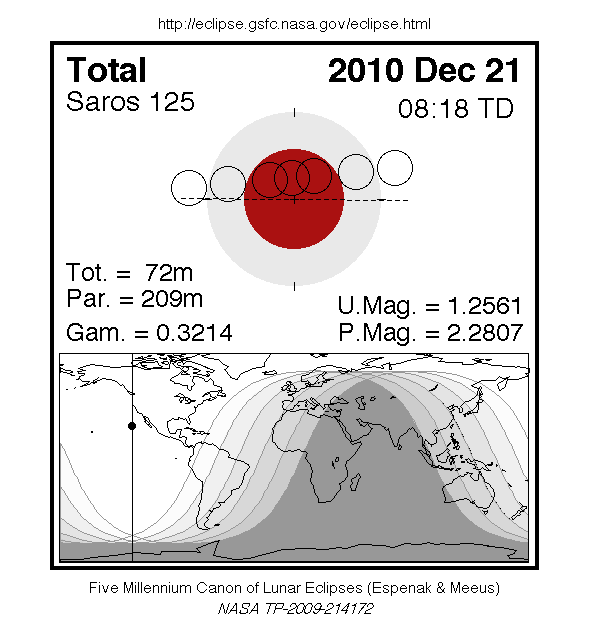The last lunar eclipse of 2010 is especially well placed for observers throughout North America. The eclipse occurs at the Moon's descending node in eastern Taurus, four days before perigee.
The Moon's orbital trajectory takes it through the northern half of Earth's umbral shadow. Although the eclipse is not central, the total phase still lasts 72 minutes. The Moon's path through Earth's shadows as well as a map illustrating worldwide visibility of the event are shown in Figure 4. The timings of the major eclipse phases are listed below.
Penumbral Eclipse Begins: 05:29:17 UT Partial Eclipse Begins: 06:32:37 UT Total Eclipse Begins: 07:40:47 UT Greatest Eclipse: 08:16:57 UT Total Eclipse Ends: 08:53:08 UT Partial Eclipse Ends: 10:01:20 UT Penumbral Eclipse Ends: 11:04:31 UT
The entire event is visible from North America and western South America. Observers along South America's east coast miss the late stages of the eclipse because they occur after moonset. Likewise much of Europe and Africa experience moonset while the eclipse is in progress. Only northern Scandinavians can catch the entire event from Europe. For observers in eastern Asia the Moon rises in eclipse. None of the eclipse is visible from south and east Africa, the Middle East or South Asia.
Table 6 lists predicted umbral immersion and emersion times for 20 well-defined lunar craters. The timing of craters is useful in determining the atmospheric enlargement of Earth's shadow (see Crater Timings During Lunar Eclipses).
The December 21 total lunar eclipse belongs to Saros 125 a series of 72 eclipses in the following sequence: 17 penumbral, 13 partial, 26 total, 9 partial, and 7 penumbral lunar eclipses (Espenak and Meeus, 2009). Complete details for the series can be found at:








No comments:
Post a Comment